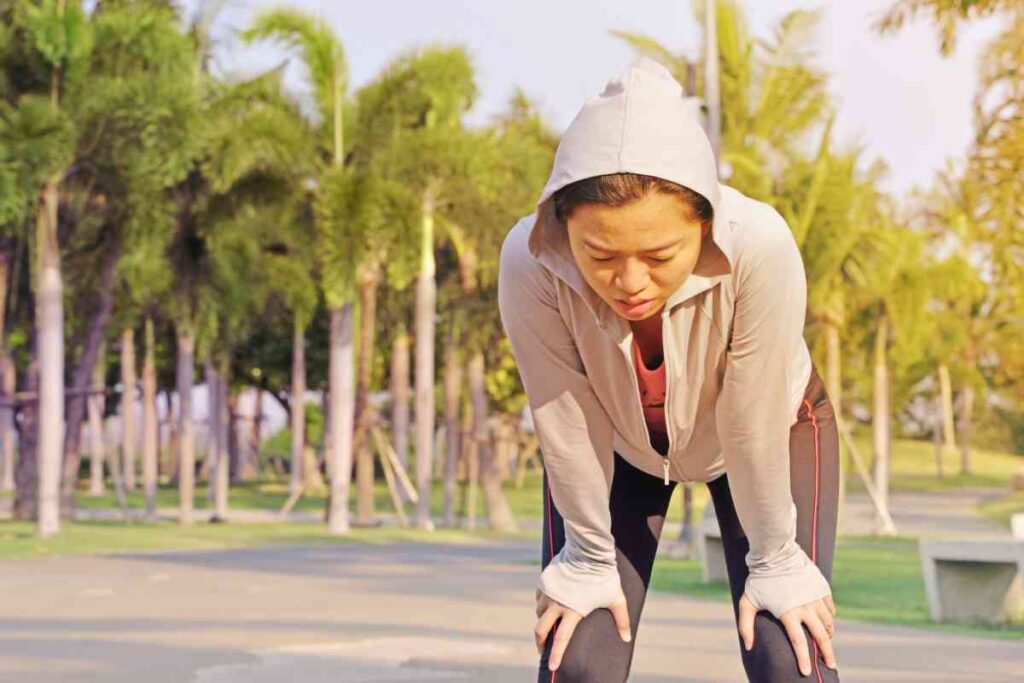Oura Blood Oxygen Monitoring Explained
If your blood oxygen doesn’t remain stable, this implies that you have health problems. Does Oura measure blood oxygen?

Does Oura Measure Blood Oxygen?
Yes, the Oura Ring measures how saturated your blood is with oxygen. This tells you how good your body is at circulating and absorbing oxygen. If your blood oxygen drops during the night, this implies that you have sleep apnea.
I have a mild case of sleep apnea, which I wasn’t aware of until I bought an Oura Ring. When trying to improve my sleep, I noticed that my breath gave out during the night many times.
How Does Blood Oxygen Sensing Work?
The Oura Ring uses red and infrared LED lights to find out information about you, including your blood oxygen levels. It sends light from the LEDs into your finger. The light is reflected back, and a sensor picks it up and measures it.
If the blood is well-oxygenated, it reflects red light but absorbs infrared light. If the blood lacks oxygen, it is the other way around and more infrared light is reflected.
Where Does it Show Your Blood Oxygen Levels?
Go to the sleep tab to see your oxygen levels. Average Blood Oxygen is how high your oxygen is on average while you are sleeping. There is also a breathing regularity graph, which includes variations in how oxygenated your blood is.
You have to sleep for at least three hours for the Oura Ring to record your blood oxygen. Shorter periods of sleep are considered naps and the Oura Ring won’t look at your oxygen levels.
How Do You Use the Blood Oxygen Sensor?

Your Oura Ring records blood oxygen by default, so you don’t have to do anything to activate it. However, if it is turned off for some reason, you will have to turn it on.
First, go to the home tab on your Oura App. Then, tap the three lines at the top left part of the screen to open a menu.
Go over to blood oxygen sensing or breathing regularity and toggle it on. Make sure your phone is connected to your ring wirelessly or else this won’t work. During your next sleep of at least three hours, the ring will monitor your blood oxygen.
What is Sleep Apnea?
Someone with sleep apnea stops breathing during the middle of the night, making them wake up to breathe.
This can happen many times during the night, preventing them from sleeping properly and making them chronically tired.
Most people who wake up tired do not have sleep apnea. However, you may have the condition if you experience any of the following:
- Someone else notices you stop breathing during sleep
- You notice you stop breathing during sleep
- You are tired, can’t stay asleep, and staying in bed for a long time doesn’t make you feel rested
- Irritability, poor focus, or headaches
- Loud snoring
Can Oura Detect Sleep Apnea?
The Oura Ring measures how many times you wake up during the night, how long you stay asleep, and what stages of sleep you enter.
The Oura Ring also measures your breathing. You can figure out that you have sleep apnea by putting the Oura Ring’s information together.
It is a common disorder, affecting one in twelve men and one in twenty women. Talk to your doctor and get an official diagnosis. Even if you are fairly sure you have sleep apnea, it could be a different problem instead.
Can the Blood Oxygen Sensor Detect Sleep Apnea?
The Oura app will rate your blood oxygen stability. If you get a low rating, this means your breathing stops during the night and you might have sleep apnea.
The four ratings are:
Optimal – Particularly regular breathing. The app will not even display a timeline showing your breathing throughout the night because you breathed regularly the whole time.
Good – Some variations, but nothing is wrong. The app will display a breathing regularity graph for the whole night.
Fair – Your blood oxygen dipped sometimes during the night.
Pay Attention – Your blood oxygen dipped frequently during the night. You may want to talk to your doctor about whether you have sleep apnea.
What if Your Ring Doesn’t Display Any Information?

If blood oxygen sensing is toggled on, but your ring still won’t display any information, try the following:
- Make sure that you have the newest software installed.
- Don’t go to bed with fairly little battery life left. Keep your ring charged.
- Make sure that the ring fits your finger properly. If it is too loose, the ring won’t work properly.
- Don’t leave either your ring or your phone on airplane mode.
- Make sure your phone, tablet, or other device’s Bluetooth is turned on.
What Causes Sleep Apnea?
Sleep apnea happens when either the throat muscles relax at the wrong time (obstructive sleep apnea) or the brain isn’t sending the right signals (central sleep apnea). There are many things that put you at higher risk of the illness:
- Smoking
- Being overweight
- Having a thick neck
- Tonsils blocking the airway
- Family history of the disease
- Alcohol use
- Certain medications that relax the throat muscles
- Difficulty breathing through your nose
- Heart disease
How Can You Treat Sleep Apnea?
For severe cases, you may need a sleep apnea mask hooked up to a compressed air machine. This will prevent the airways from collapsing and help you keep breathing and remain asleep.
If your problem is serious, you should get it treated, because sleep apnea raises the risk of many other illnesses. Chronic poor sleep for years isn’t something you should have to suffer through.
Always make sure you talk to a doctor and get the right diagnosis and the right treatment. While an Oura Ring can make it pretty clear that you have sleep apnea, you cannot use the ring to diagnose the disease. A doctor will diagnose the disease using different methods.
What Does Oura Measure?
The Oura Ring measures a lot of different things with its high-tech sensors. It measures the following:
- Your heart rate and variability in heart rate
- Your blood oxygen during the night
- How many calories you burn
- How many steps you take
- Your blood pressure
- Your blood glucose levels
- Your body temperature
- Your sleep, including the quality of your sleep
Two things the Oura Ring doesn’t measure properly are weight training and yoga. The ring doesn’t give you nearly enough credit for these activities, because they improve your health without burning a huge number of calories.
The Oura Ring also doesn’t offer some of the features of a smartphone or a computer. You cannot use it to send and receive messages or to play music. There is also no room for a screen on the small ring, so you control everything from a smartphone app.
What Should Your Average Heart Rate Be?
A normal heart rate is between 60 and 100 beats per minute when you are not doing anything physically active. If your resting heart rate is above 100, you may be unhealthy and need exercise to strengthen your heart.
A resting heart rate below 60 is usually positive. An athlete may have a resting heart rate significantly below 60 beats per minute.
Does Oura Do EKG?
An EKG (more commonly ECG) is an electrocardiogram, which is the most accurate way to measure heart rate. Athletes use this technology when improving their maximum heart rate.
The Oura Ring does not use ECG technology. However, it does report very similar results for heart rate and heart rate variability compared to ECG technology.
What Sensors Are In Oura?
Half of what makes the Oura Ring impressive is the AI and the other half is the high-tech sensors. The Oura Ring has infrared sensors to measure your breathing and heartbeat, a 3D accelerometer to record your movement, and another type of sensor for your body temperature.
An Accelerometer
When you move your hand from side to side or up and down, the Oura Ring’s accelerometer detects this movement. It can measure movement in three dimensions. This helps the Oura Ring determine how active you are, how many steps you take, how many calories you burn, and even how well you are sleeping.
While you can measure the intensity of many types of workouts from hand movement, you can’t measure everything this way. For example, an Oura Ring cannot measure the intensity of a yoga session from how you move your hands.
In these cases, you can manually enter what you did and have the Oura Ring consider it for your activity score. The accelerometer is not always right (the number of steps you take will be approximate, as it won’t always count each step) but it is more than good enough for its purposes.
PPG (Infrared Photoplethysmography) Sensors
PPG sensors use infrared light to measure your heart rate accurately. When your heart beats, capillaries expand and contract. A photoplethysmography sensor uses light to detect changes in the amount of blood flowing through the capillaries. When the capillary is full of blood, most of the light is absorbed and not reflected back to the sensor.
The Oura Ring uses its LED to check the amount of blood in the capillaries 250 times per second. It is about 99.9% accurate at detecting how much blood is moving through the capillaries. The Oura Ring has a light sensor on both sides, compared to usually only one light sensor for fitness trackers.
NTC (Negative Temperature Coefficient) Sensors
Your Oura Ring can also use your body temperature to collect a great deal of information about you. If you are about to get sick, your body temperature may change. The Oura Ring will also use your body temperature to determine which stage of sleep, (Deep, Light, or REM) you are in.
Unlike some fitness trackers, the Oura Ring measures your body temperature by directly touching your skin, not measuring the air close to it. It can detect changes as small as a tenth of a degree. The Oura Ring shows you how close your body temperature is to what it is normally.
Key Takeaways
- The Oura Ring measures blood oxygen levels using red and infrared light sensors.
- If your blood oxygen drops many times during the night, you may have sleep apnea.
- Talk to your doctor and see if you have sleep apnea. If you do, get it treated, because it raises the risk of many other disorders.